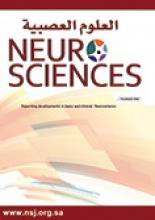Abstract
OBJECTIVE: To study the use of M-latency (ML) as an electrodiagnostic parameter for diagnosis of carpal tunnel syndrome (CTS).
METHODS: One hundred and one consecutive patients (77 females, mean age 42 years and 24 males, mean age 46 years) referred with a clinical diagnosis of CTS to the Neurodiagnostic laboratories at the King Fahd Hospital of the University, Al-Khobar, Kingdom of Saudi Arabia were evaluated between November 1999 and October 2000. Standardized nerve conduction studies on 191 hands, including 191 median and 108 normal ulnar nerves were performed.
RESULTS: The results were categorized into 3 groups based on using (A) distal sensory peak latencies (DSL) >=3.5 ms, (B) DSL <3.5 ms and (C) DSL <3.5 ms and ML <4.0 ms. The ML was significantly longer than the distal motor latency (DML) for the median nerves in groups (A) and (B) but not in group (C). There was no significant difference between ML and DML for the normal ulnar nerves in all 3 groups. By using the combined DSL <3.5 ms and ML >=4.0 ms parameters, the diagnostic yield of 147 (77%) from group (A) increased by an additional 10 patients (5%) to reach 157 (82%).
CONCLUSION: The M-latency may be utilized as a more sensitive parameter than DML, in combination with DSL, for confirmation of CTS in symptomatic patients with borderline distal sensory latencies.
- Copyright: © Neurosciences
Neurosciences is an Open Access journal and articles published are distributed under the terms of the Creative Commons Attribution-NonCommercial License (CC BY-NC). Readers may copy, distribute, and display the work for non-commercial purposes with the proper citation of the original work.






